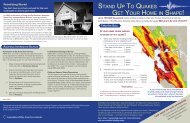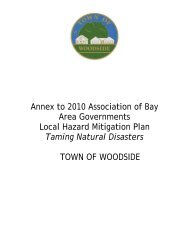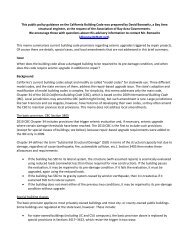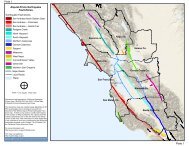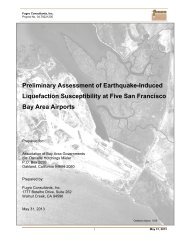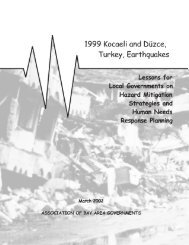Safe Enough to Stay - ABAG Earthquake and Hazards Program
Safe Enough to Stay - ABAG Earthquake and Hazards Program
Safe Enough to Stay - ABAG Earthquake and Hazards Program
- No tags were found...
Create successful ePaper yourself
Turn your PDF publications into a flip-book with our unique Google optimized e-Paper software.
<strong>Safe</strong> <strong>Enough</strong> <strong>to</strong> <strong>Stay</strong>Figure 1: Comparing the Effects of Recent DisastersLoma Prieta <strong>Earthquake</strong> (1989), 12 San Francisco Bay AreaUninhabitable units 11,500Uninhabitable units as a percentageof housing in the affected areaPercentage of uninhabitable unitsthat were in multifamily buildingsMore than 1% in Oakl<strong>and</strong> <strong>and</strong> San Francisco, 10% in Watsonville <strong>and</strong>Santa Cruz60%Degenkolb EngineersOutmigrationHousing reconstruction time frameMore than 1,000 left Santa Cruz/Watsonville area; Oakl<strong>and</strong> reported2,500 new homeless; similar numbers assumed for San FranciscoTwo years for single-family <strong>and</strong> most market-rate apartments; seven <strong>to</strong>10 years <strong>to</strong> replace/repair affordable housing units in three countiesHurricane Andrew (1992), 13 MiamiUninhabitable units 80,000Uninhabitable units as a percentageof housing in the affected areaPercent of uninhabitable units thatwere in multifamily buildings6% in South Dade County29%flickr user fo<strong>to</strong>gakeOutmigrationHousing reconstruction time framePermanent dispersion of 25,000 <strong>to</strong> 30,000 households (21,000 jobslost with Homestead base closure, which exacerbated outmigration)75% of single-family units in two years; very limited multifamily housingreconstructedNorthridge <strong>Earthquake</strong> (1994), 14 Los AngelesUninhabitable units 60,000Uninhabitable units as a percentageof housing in the affected areaPercent of uninhabitable units thatwere in multifamily buildings3% in San Fern<strong>and</strong>o Valley, 1.5% in Los Angeles88%flickr user st<strong>and</strong>ardpixelOutmigration Minimal: people rehoused in vacant units due <strong>to</strong> pre-earthquake 9.3%vacancy rateHousing reconstruction time frame80% in two years; typically two years <strong>to</strong> repair <strong>and</strong> four years <strong>to</strong> rebuilddamaged housing units12 Data from Comerio, Mary C., Disaster Hits Home (Berkeley, CA: University ofCalifornia Press, 1998).13 Ibid.14 Ibid.15 Data from Olshansky, Robert B., Laurie A. Johnson <strong>and</strong> Kenneth C. Topping,Opportunity in Chaos: Rebuilding After the 1994 Northridge <strong>and</strong> 1995 Kobe<strong>Earthquake</strong>s (2005) www.urban.illinois.edu/faculty/olshansky/chaos/chaos.html.Additional data estimates from Professor Mary Comerio, UC Berkeley.16 Data estimate from Professor Mary Comerio, UC Berkeley.17 Note that the January 2005 population exceeded pre-earthquake levels,but population distribution changed. Four western Kobe wards (Tarumi, Suma,Nagata <strong>and</strong> Hyogo) had smaller populations; for example, Nagata ward was onlyat 80 percent of its January 1995 population.18 Recovery Briefing Book, Gr<strong>and</strong> Forks, North Dakota: Flood RecoveryBrief, Informational Resources <strong>and</strong> Recovery Lessons Learned (City of Gr<strong>and</strong>Forks, North Dakota, 2006); “Information on City Governance, 1997 FloodPreparations, Damage <strong>and</strong> Recovery,” (City of Gr<strong>and</strong> Forks, North Dakota,2008).19 Data from Olshansky, Robert B. <strong>and</strong> Laurie A. Johnson, Clear as Mud:Planning for the Rebuilding of New Orleans (Chicago, IL <strong>and</strong> Washing<strong>to</strong>n, DC:American Planning Association, 2010).20 This is the number of uninhabitable units for New Orleans. The <strong>to</strong>tal numberof uninhabitable units in the Gulf Coast region is 500,000.21 Data from Professor Mary Comerio, UC Berkeley.10 SPUR Report > January 2012



